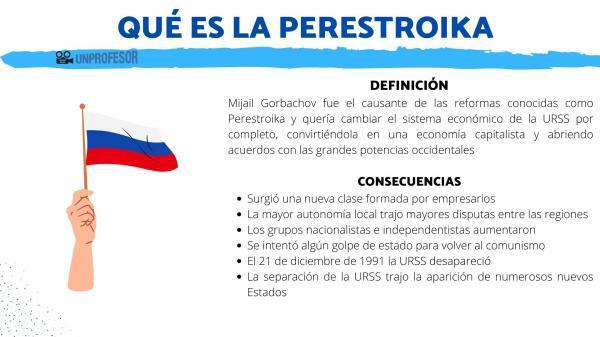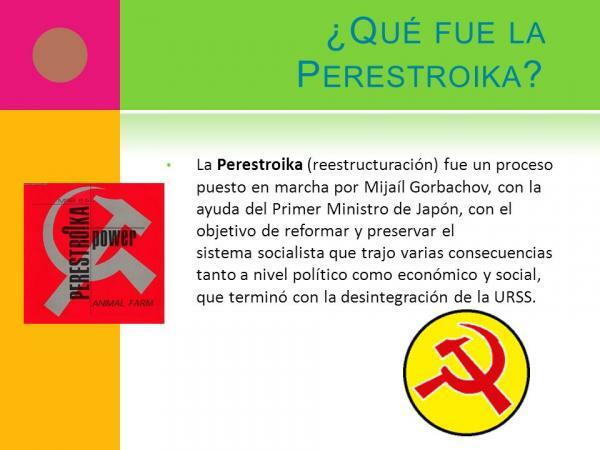What is PERESTROIKA

Of all the reforms carried out by companies, the most important are usually economic, being great changes in the structures of a society that can lead to enormous inequalities in a country. One of the economic reforms best known is the one that took place in the USSR in 1985, being one of the causes of the enormous changes suffered by the Soviets in a few years. To talk about it, in this lesson from a teacher we must discover you what is Perestroika.
To understand the importance of this economic reform, we must talk about the background of the Perestroika, to understand the causes that led the Soviet government to carry out this economic reform so complex.
For years, the USSR had been focused on Cold War, being an ideological conflict that faced the communists, led by the USSR, against the capitalist system led by the United States. For decades both countries had fought for their economic system to be the main one, thus causing dozens of wars in small countries.
This enormous conflict affected the economy of the USSR, not only because of the complexity of not being able to negotiate trade agreements with capitalist countries, but also because the creation of weapons and technology caused the economy of the Russian giant to enter a serious crisis. In this crisis situation
Mikhail Gorbachev came to power as general secretary of the Communist Party, who although at first said that his government was not going to change the communist system of the USSR, he lied and he was the cause of the reforms known as Perestroika.Gorbachev in 500 days he wanted to change the economic system of the USSR completely, turning it into a capitalist economy and opening agreements with the great Western powers that for years had been his enemies. The idea was that at first the USSR would only be a Marxist state with some presence of the law of supply and demand, but that over the years evolved towards the model capitalist.
To continue this lesson on what is Perestroika, we must talk about the main characteristics of this economic reform, in order to understand the enormous importance of this for the history of the USSR. The main characteristics of Perestroika are the following:
- A kind of democratization of the economic system, but also from other aspects of the Russian population such as politics or society.
- The idea behind the reform was to turn the USSR into one of the greatest economic powers in the world, leaving behind the communist vision from Stalin and Lenin.
- The economic crisis was considered to be the cause of the poor organization of the Russian state, so the best idea to save it was embrace the freedom of the market and that it was the market itself that would solve the problems.
- The press was released, eliminating censorship and allowing for the first time in decades that newspapers and television could release any type of information without fear of reprisals.
- The decentralization of decisions, increasing local autonomy to reduce corruption and create a better and wider market. In the long run this was one of the reasons for the dismemberment of the USSR.
- One of the most complicated reforms were those related to measures against alcoholism, causing a huge reduction in the number of people suffering from this problem.
- Relationships stopped with the most important socialist powers, especially cutting agreements with China.
- I know relations improved with many of the western countries, as for example with the United States that during decades had been the enemy of him.

Image: Slidesplayer
Although the intention of Gorbachev with the reforms was ameliorate the serious crisis suffered by the USSR, this did not work out quite well, as the reforms aggravated several problems and caused some new ones, which had dire consequences for the USSR. The main consequences of Perestroika were the following:
- A new class made up of entrepreneurs, being the first time in decades that people could get rich without working, ending the workers' struggle typical of the communists.
- Greater local autonomy brought major disputes between regions, which wanted more power and were increasingly separated from each other, ending Soviet nationalism.
- The nationalist and independence groups their numbers increased throughout the region, with attacks or hatred due to ethnic differences between the regions being very common.
- Some attempt was made coup to return to communism, since a large part of the political class was against Gorbachev's ideas, and although it was close, it was never achieved.
- December 21, 1991 the USSR disappeared as such, largely due to the problems caused by Perestroika and especially by the economic crisis and by the increase in power of the republics that Gorbachev had defended so much.
- The separation from the USSR brought the appearance of numerous new states, which caused great problems in a Europe that thought it was at peace and that saw conflicts appear in the area.




